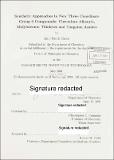Synthetic approaches to new three coordinate Group 6 compounds : chromium alkenyls, molybdenum thiolates and tungsten amides
Author(s)
Greco, Jane Brock, 1973-
DownloadFull printable version (43.42Mb)
Alternative title
Synthetic approaches to new 3 coordinate Group Six compounds : chromium alkenyls, molybdenum thiolates and tungsten amides
Other Contributors
Massachusetts Institute of Technology. Department of Chemistry.
Advisor
Christopher C. Cummins.
Terms of use
Metadata
Show full item recordAbstract
A series of alkenyl (-C[Ad]Ar) and thioalkenyl (-SC[Ad]Ar, Ad=2-adamantylidene, Ar=3,5-Me2C6H3, 4-tBuC6H4, 3,5-(C6H5)2C6H3, 3,5-(4-tBu-C6H4)2 C6H3) ligands have been prepared. The alkenyl ligands are synthesized by bromination and dehydrohalogenation of an adamantyl olefin to yield an alkenyl bromide. The Grignard reagent, derived from the bromide, is used either as a transmetallation reagent, or reacted with elemental sulfur to form a magnesium thiolate, (THF)2Mg(SC[Ad]Ar)2. The magnesium thiolate can be protonated to give a free thiol, oxidized to afford a disulfide or reacted with ClTi(O'Pr)3 to give the titanium reagent, Ti(SC[Ad]Ar)(O'Pr)3. Treatment of CrC13 with an alkenyl Grignard reagent forms the Cr(III) complex, (THF)Cr(C[Ad]ArMe)3. While this compound reacts with pyridine to give (py)-Cr(C[Ad]ArMe)3, it fails to react with THT or PEt3. (THF)Cr(C[Ad]ArMe)3 can be oxidized with I2 or PhSSPh, however, the oxidation products are thermally unstable and disproportionate back to (THF)Cr(C[Ad]ArMe)3. Reactivity with nitric oxide is also discussed. Molybdenum nitrides of the form N-Mo(SC[Ad]Ar)3 have been prepared by re-action of Ti(SC[Ad]Ar)(O'Pr)3 with N-Mo(OtBu)3. The nitride reacts with Mo(N-[R]ArMe)3 to give (IL-N)[Mo(SC[Ad]Ar)3]2. Reaction of (THF)2Mg(SC[Ad]Ar)3 with MoCl3(THF)3 in diethyl ether leads to the formation of a molybdenum-molybdenum triply bonded compound, Mo2(SC[Ad]Ar)6, while performing the same reaction in THF followed by addition of pyridine leads to the isolation of (py)Mo(SC[Ad]Ar)3. (cont.) A series of tungsten nitrides with amide ligands, NW(NMe2)3, N-W(N[iPr]-ArMe)2(NMe2), and NW(N['Pr]ArMe)3 have been synthesized by the reaction of a titanium or zirconium amide reagent with N-W(OtBu)3. Nitride N-W(N['Pr]-ArMe)3 has been compared to the molybdenum analogue N-Mo(N['Pr]ArMe)3 on the basis of crystal structure data and Density Functional Theory calculations. Treatment of N-W(NMe2)3 with Mo(H)(172-Me2C=NArMe)(N[iPr]ArMe)2 leads to formation of (Me2N)3W(/u-N)Mo(N[iPr]ArMe)3. Reaction of (Me2N)3W(tL-N)Mo(N[iPr]-ArMe)3 with other small molecules leads to the transfer of the nitride atom from tungsten to molybdenum. However, in the case of the larger nitride, NW(N['Pr]-ArMe)3, the bridging nitride formed with Mo(H)(r72-Me2C=NArMe)(N['Pr]ArMe)2 is present in solution in equilibrium with the starting materials. The rate of proton transfer self exchange of [C-Mo(N[R]ArMe)3]- with HCMo-(N[R]ArMe)3 has been measured by line shape kinetics in the 13C NMR and found to be 7 x 106 M-1 s-1. This very fast proton transfer rate has been used, in conjunction with solution and solid state NMR studies and DFT calculations, to develop a bonding picture for the carbide anion in which the lone pair on the carbon is localized in a nonbonding s orbital.
Description
Thesis (Ph. D.)--Massachusetts Institute of Technology, Dept. of Chemistry, 2001. Includes bibliographical references (leaves 161-175).
Date issued
2001Department
Massachusetts Institute of Technology. Department of ChemistryPublisher
Massachusetts Institute of Technology
Keywords
Chemistry.